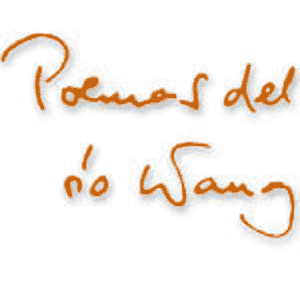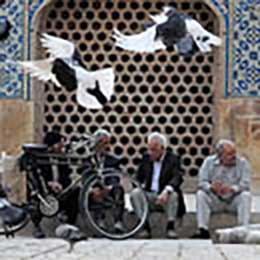
 Sapete di quale villaggio si tratta, è vero? No, no. Non abbiate fretta con la risposta. Questo non è il villaggio di Astrix, in Bretagna. Ma piuttosto quella, dove i veri Asterix vissero:
Sapete di quale villaggio si tratta, è vero? No, no. Non abbiate fretta con la risposta. Questo non è il villaggio di Astrix, in Bretagna. Ma piuttosto quella, dove i veri Asterix vissero:  Tiscali in Sardegna.
Tiscali in Sardegna. Da quando le legioni romane nel 238 aC, durante le guerre puniche conquistarono la Sardegna, gli abitanti dei villaggi videro in loro l’odioso invasore, il che non è sostanzialmente cambiato fino ad oggi, proprio come i romani hanno visto il barbaro nei sardi, da Catone ai giorni nostri.
 Coro di Bitti: Cantu a tenore |
 La ripida e sterile catena del Supramonte si alza sopra le valli della Barbagia. All’interno della montagna, come se lo leggessimo in un romanzo romantico, si apre una valle fertile e spaziosa, la valle di Lanaittu. Il flusso Sa Oche, che sorge sul picco Pruna alto millecinquecento metri, corre attraverso di essa tra greggi e uliveti. L’unica entrata alla valle è dove il torrente sfocia nel fiume Cedrino, e dove il fiume stesso impedisce qualsiasi intrusione nella valle. Un terreno ideale per la difesa. I resti di una trentina di antici villaggi sardi sono stati scavati nella valle, che resistette le legioni per almeno un secolo dopo la conquista romana. E quando la parte bassa della valle non era più sicura contro gli invasori, i sardi salirono alla testata della valle, sul monte Tiscali, dove sembra che abbiano sopravvisuto senza disturbo alla caduta di Roma.
La ripida e sterile catena del Supramonte si alza sopra le valli della Barbagia. All’interno della montagna, come se lo leggessimo in un romanzo romantico, si apre una valle fertile e spaziosa, la valle di Lanaittu. Il flusso Sa Oche, che sorge sul picco Pruna alto millecinquecento metri, corre attraverso di essa tra greggi e uliveti. L’unica entrata alla valle è dove il torrente sfocia nel fiume Cedrino, e dove il fiume stesso impedisce qualsiasi intrusione nella valle. Un terreno ideale per la difesa. I resti di una trentina di antici villaggi sardi sono stati scavati nella valle, che resistette le legioni per almeno un secolo dopo la conquista romana. E quando la parte bassa della valle non era più sicura contro gli invasori, i sardi salirono alla testata della valle, sul monte Tiscali, dove sembra che abbiano sopravvisuto senza disturbo alla caduta di Roma.
Oggi un ponte conduce sul fiume Cedrino, attraverso indisturbato. Albeggia. Le rocce del Supramonte sono ancora coperte di nuvole, ma sotto sotto sono già visibili i vigneti, i cui primi vitigni furono innestati dai gesuiti nella vicina Oliena dall’antico vitigno selvatico che cresce nell’isola da tremila anni. La strada sale lentamente verso l’alto, si possono già vedere dall’alto le scogliere del canyon del Cedrino, e, guardando indietro, la valle di Oliena. Poi si svolta bruscamene nella valle di Sa Oche. Continuo la via tra uliveti. Nelle rocce calcaree qua e là si aprono grotte: la Grotta Rifugio, il luogo di sepoltura di sette mila anni del popolo Bonu Ighinu, la Grotta del Guano, dove si sono trovate le statue di dee di sei mila anni del popolo Ozieri, la cava doppia Sa Oche e Su Ventu con le tracce di un insediamento umano di ventimila anni, e la
 Grotta Corbeddu, dove il famoso capobandito Giovanni Corbeddu Salis nascose alla fine dell’Ottocento. E un poco più tardi appare, al di sopra delle chiome degli ulivi, la vetta frastigliata del monte Tiscali.
Grotta Corbeddu, dove il famoso capobandito Giovanni Corbeddu Salis nascose alla fine dell’Ottocento. E un poco più tardi appare, al di sopra delle chiome degli ulivi, la vetta frastigliata del monte Tiscali.


 After crossing the stream, the road begins to rise sharply. The sun is already shining, the pervasive junipers perfume the air. I repeatedly look back, watching the valley through which I have come emerging from behind the trees. I arrive at a
After crossing the stream, the road begins to rise sharply. The sun is already shining, the pervasive junipers perfume the air. I repeatedly look back, watching the valley through which I have come emerging from behind the trees. I arrive at a  wide limestone plateau, from which a great panorama opens to as far as the entrance of the valley. From somewhere deep you can hear bleating and dogs barking. Here must be the hut of the shepherd whom I will soon meet. I look at the map. There are five hundred meters to go, but it notes that the remaining time as one hour. As I go ahead, I increasingly understand why.
wide limestone plateau, from which a great panorama opens to as far as the entrance of the valley. From somewhere deep you can hear bleating and dogs barking. Here must be the hut of the shepherd whom I will soon meet. I look at the map. There are five hundred meters to go, but it notes that the remaining time as one hour. As I go ahead, I increasingly understand why.A steep path turns up from the plateau to the rock towering above me. On its edge, the wind-torn, barkless pines of Chinese ink drawings cling to the mountain cracks. I have to cross the forty meter-high, two meter-wide rift of the rock, the trunks of fallen trees are the stairs. A long horizontal indentation stretches along the rock wall: only a few million years ago, the sea was eroding the coastal cliffs here. Then came the ice, which, in retreat, scraped lunar formations onto the surface of the rock.



The holes carved by the ice offer ideal protection for the vegetation on the windswept plateau. Each hole and dent houses a small garden, which holds on with enormous force to life in the grip of the barren rock, just like the Sardinians. On the earth slowly amassing at the bottom of the holes, a multitude of seeds are waiting patiently for their turn.
Bach: 5th Cello Suite, BWV 1011, Courante. Isang Enders, 2014

 Arriving on the plateau, a hundred meter-wide crater opens up in front of me. The roof of a giant cave was torn millions of years ago, and the cave became a hidden valley. Here the Sards coming up from the valley built their new village, which was never found by the Romans. In the middle of the crater, a piece of the former roof stands vertically, like a huge megalith, and on the side of the cave, just in the right place, a large natural window opens, from where they could constantly keep an eye on the valley. The remains of about fifty houses were excavated at the bottom of the crater. A few hundred people lived here, living on shepherding and looting, just like the whole population of the Barbagia in the following two millennia.
Arriving on the plateau, a hundred meter-wide crater opens up in front of me. The roof of a giant cave was torn millions of years ago, and the cave became a hidden valley. Here the Sards coming up from the valley built their new village, which was never found by the Romans. In the middle of the crater, a piece of the former roof stands vertically, like a huge megalith, and on the side of the cave, just in the right place, a large natural window opens, from where they could constantly keep an eye on the valley. The remains of about fifty houses were excavated at the bottom of the crater. A few hundred people lived here, living on shepherding and looting, just like the whole population of the Barbagia in the following two millennia.
We do not know how life stopped here. It seems not as a result of a cataclysm, but rather the inhabitants gradually moved down to the valley after the fall of Roman rule. Then, the village was forgotten for two thousand years. However, in 1863 the regulation of the Piedmontese government gave a green light to the deforestation of Sardinia, which was done for about a hundred years by entrepreneurs from Turin. They devastated whole hillsides in order to provide the developing Italian industry with wood for building. The collapsed cave with the remains of Tiscali village was found by lumberjacks. A race between the archaeologists and treasure-seekers started. The first researchers still saw and described as relatively intact the stone walls of the houses, which have been quite destroyed by a hundred years of treasure hunting.



Like Petrarca, when reaching the top of Mons Ventosus, I also take out a book on the summit of the windy mountain, the monograph Tiscali by Elio Aste. The erudite summary guides you calmly and meticulously, with a broad overview and ornamented Italian rhetoric through the geological structure and development of the region, describes the historical sources, confronts the archaeological hypotheses, reconstructs the wall remains. Only the final sentence of the book reads as unusual in a scientific work:
“During our extraordinary journey, we have been enriched with a unique experience, which prompts reflexion, the reception and understanding of the far away message left to us by our forefathers in the dolina of Tiscali: that human freedom and dignity are priceless, even if we have to preserve them at the cost of a difficult life full of indigence and heavy dangers.”
And the historical arguments are enlarged by a three-page appendix, an ode peppered with Sardinian dialectal words and densely annotated, a sublime poem, by none other than the learned author himself: Ode to the heroes of Lanaittu.
| “…For thousands of years, in the deep womb of the rock a nest is hidden, a nest of armed men, who, like bold eagles are always ready for battle and looting. In a secret shelter of the rock they waited for the female wolf, the ferocious beast, hungry for glory and conquest, who was brought by the centuries to the entrance of the valley to rob flocks and ravage hearths until, satisfied, set up her haunt there. | And in a night without moonshine the horn snapped, the valley was shaken! They pounced on the wolf, the great beast, hungry for glory and conquest, and on her invading and devastating army, who did not yet know the power of the Sards. Thus they took revenge for the hearths ravaged the fathers murdered, the women raped. On that night, the river ran with blood, alien blood sprinkled the land of Lanaittu!” |
The Sard, who does not forget after two thousand years, came out of the erudite author. The chronicle of the people of Tiscali is not yet over.

























Add comment